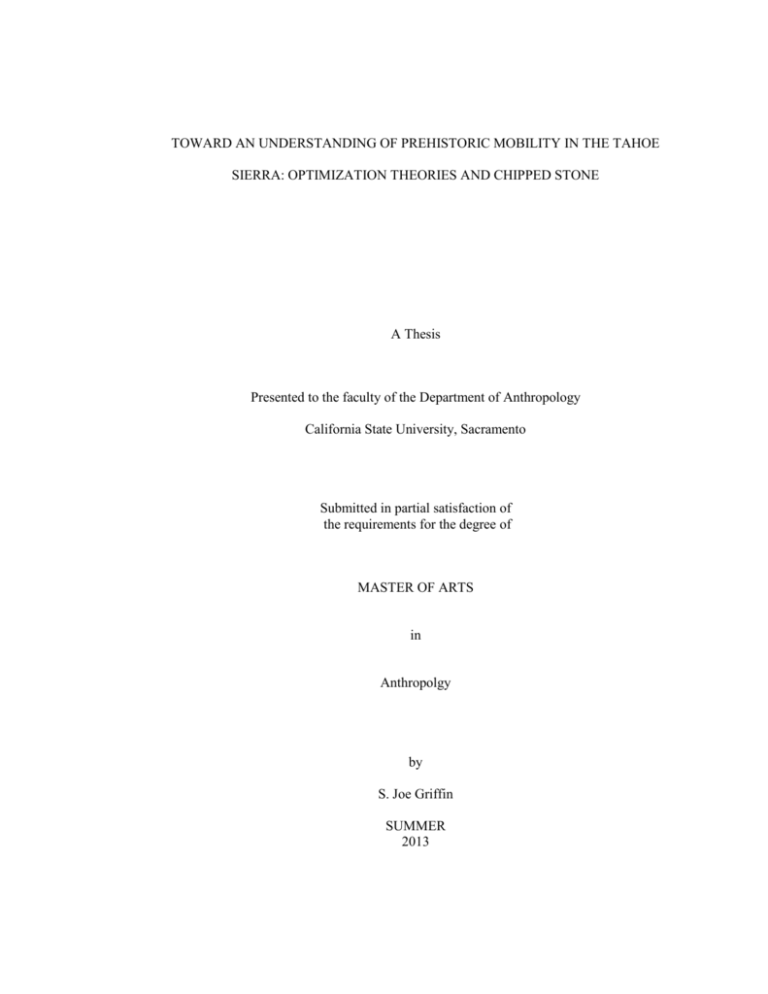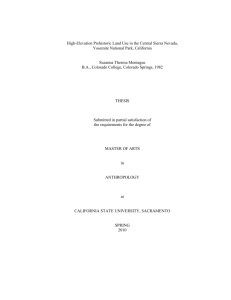
TOWARD AN UNDERSTANDING OF PREHISTORIC MOBILITY IN THE TAHOE
SIERRA: OPTIMIZATION THEORIES AND CHIPPED STONE
A Thesis
Presented to the faculty of the Department of Anthropology
California State University, Sacramento
Submitted in partial satisfaction of
the requirements for the degree of
MASTER OF ARTS
in
Anthropolgy
by
S. Joe Griffin
SUMMER
2013
© 2013
S. Joe Griffin
ALL RIGHTS RESERVED
ii
TOWARD AN UNDERSTANDING OF PREHISTORIC MOBILITY IN THE
TAHOE SIERRA: OPTIMIZATION THEORIES AND CHIPPED STONE
A Thesis
by
S. Joe Griffin
Approved by:
__________________________________, Committee Chair
Dr. Mark Basgall
__________________________________, Second Reader
Dr. Michael Delacorte
__________________________________, Third Reader
Dr. David Zeanah
____________________________
Date
iii
Student: S. Joe Griffin
I certify that this student has met the requirements for format contained in the University
format manual, and that this thesis is suitable for shelving in the Library and credit is to be
awarded for the thesis.
__________________________, Graduate Coordinator ___________________
Dr. Michael Delacorte
Date
Department of Anthropology
iv
Abstract
of
TOWARD AN UNDERSTANDING OF PREHISTORIC MOBILITY IN THE
TAHOE SIERRA: OPTIMIZATION THEORIES AND CHIPPED STONE
by
S. Joe Griffin
For more than fifty years archaeologists have wrestled with the archaeological record of
the Tahoe Sierra, an area in which chronological control and material preservation have
remained generally elusive. This thesis represents an attempt to gain insight into prehistoric
human adaptation through changing patterns of residential mobility reflected in Holocene
lithic assemblages. As a starting point, this thesis works from the simple hypothesis that
residential mobility would have progressively declined through time.
The thesis focuses on two aspects of residential mobility: mobility magnitude (i.e. the
distances people moved) and mobility frequency (i.e. how often groups of people moved).
Bringing to bear a broad range of analyses used profitably by archaeologists in the past, this
work intends to measure mobility patterns indirectly as reflected in the lithic assemblages
recovered from four sites the Tahoe Sierra: CA-PLA-5, CA-PLA-6, CA-PLA-163, and CANEV-13/H.
A broad range of analyses were brought to bear, examining both formal tools and
debitage. These analyses were based on optimization theories, assuming that people would
v
have designed their technologies to balance a trade-off between the weight of tools carried
during residential moves and the utility of the toolkit; where different mobility strategies
would be expected to favor an emphasis on one or the other of these factors. In the context of
lithic material availability, these analyses were expected to reasonably reflect mobility,
assuming that prehistoric populations maximized the efficiency of their toolkits.
Though a difficult factor to control, an attempt was made to place these sites in a
chronological sequence using radiocarbon dates, obsidian hydration analyses, and projectile
point associations.
Expectations developed based on the hypothesis were not realized by any of the
analyses. These failures were not consistent however—a single assemblage might yield
indications of both high and low mobility based on different analyses. The final two chapters
of the thesis explore possible reasons behind these failures and suggest new hypotheses that
might better explain the results.
_______________________, Committee Chair
Dr. Mark Basgall
_______________________
Date
vi
ACKNOWLEDGEMENTS
I would like to thank my long-suffering thesis committee members, Dr.Mark Basgall,
Dr. David Zeanah, and Dr. Michael Delacorte, who endured my numerous thesis ideas, read
several prospectuses I subsequently abandoned, and made their way through a couple versions
of this thesis. The Archaeological Research Center at Sacramento State kindly let me store the
collections there during my analyses and gave me 24-hour access to the facility.
Brian James II, started classes at the same time as I did, was in almost all my classes,
and was always eager to help me tilt at one windmill after another—from getting lost along
Cache Creek to helping me test one harebrained idea after another in the Martis Valley.
Thanks man. Dr. Sue Lindstrӧm demonstrated the incredible depth of knowledge it is possible
to have about an area and shared her knowledge freely. At the U.S. Army Corps of Engineers
I would like to thank (the now retired) Dr. Sannie Osborn who hired me, encouraged me to go
down this path for my thesis, and always supported my needs for time off with little or no
warning. In addition to politely glazing over while I rambled on endlessly about one idea or
another about the local archaeology, Richard Perry gave me mostly free rein over our site
recording work at Martis Creek Lake, a privilege which I hope I didn’t abuse too badly.
The California State Archaeological Collections Research Facility in West
Sacramento and Mr. Terry Hanchett kindly gave me access to the collection from CA-NEV13/H. Dr. Carolyn White, Sarah Heffner, and Steven Holm of The University of Nevada
Reno; and Dr. Eugene Harrori and Rachel Malloy of the Nevada State Museum allowed me
access to the collections from CA-PLA-5, CA-PLA-6, and CA-PLA-163. Craig Skinner of
vii
the Northwest Research Obsidian Studies Laboratory generously provided me with a wealth of
FGV source data.
Most important of all: thanks to Jamie and Alyssa who put up with me coming home
from the lab in the middle of the night and ignoring them while I researched and wrote this
thing. Thanks for all your support and all the fun we had when I should have been working on
this.
Of course, all errors and omissions are mine alone.
viii
TABLE OF CONTENTS
Page
Acknowledgements.................................................................................................................. vii
List of Tables ......................................................................................................................... xiv
List of Figures ......................................................................................................................... xvi
Chapter
1. INTRODUCTION .............................................................................................................. 1
Hypotheis ...................................................................................................................... 2
Method and Structure .................................................................................................. 3
2. GEOLOGIC AND ENVIRONMENTAL SETTING .......................................................... 5
Geologic Context ......................................................................................................... 5
Climate and Environment ............................................................................................. 8
Paleoclimate..................................................................................................... 9
3. CULTURE HISTORY....................................................................................................... 12
4. CHRONOLOGY .............................................................................................................. 24
Chronological Indicators ............................................................................................ 24
Radiocarbon ................................................................................................... 24
Obsidian hydration ........................................................................................ 25
Sutro Springs obsidian hydration .................................................................. 28
Stratigraphy and superposition ...................................................................... 34
Stratigraphic integrity as NEV-13/H ............................................................. 35
Stratigraphic integrity at PLA-5 .................................................................... 38
Projectile points ............................................................................................. 40
xi
Chronology of NEV-13/H .......................................................................................... 52
Chronology of PLA-6 ................................................................................................. 54
Chronology of PLA-163 ............................................................................................. 56
Chronology of PLA-5 ................................................................................................. 57
Review of Chronological Data ................................................................................... 59
5. FINDING MOBILITY IN THE ARCHAEOLOGICAL RECORD ................................ 62
Mobility and Lithic Technology ................................................................................. 66
Other Factors that Influence the Organization of Technology ................................... 84
Trade .............................................................................................................. 84
Lithic terrain .................................................................................................. 92
Resource stress .............................................................................................. 92
Material preference ........................................................................................ 94
Technological context.................................................................................... 95
Connecting the Organization of Technology to the Archaeological Record .............. 96
6. METHODS ....................................................................................................................... 99
Magnitude of Mobility.............................................................................................. 100
Reduction phase........................................................................................... 101
Biface staging .............................................................................................. 101
Debitage size sorting ................................................................................... 104
Ratio of debitage to tools ............................................................................. 106
Frequency of Mobility .............................................................................................. 106
Tool versatility............................................................................................. 107
Tool formality .............................................................................................. 109
xii
Occupation span index................................................................................. 110
General Mobility....................................................................................................... 111
Recycling and maintenance ......................................................................... 111
Effective source distance ............................................................................. 114
7. RESULTS ....................................................................................................................... 116
Magnitude of Mobility.............................................................................................. 116
Reduction phase-biface staging ................................................................... 116
Reduction phase-debitage size sorting......................................................... 120
Ratio of debitage to tools ............................................................................. 126
Frequency of Mobility .............................................................................................. 128
Tool versatility............................................................................................. 128
Tool formality .............................................................................................. 132
Occupation span index................................................................................. 134
General Mobility....................................................................................................... 135
Recycling and maintenance ......................................................................... 135
Effective source distance ............................................................................. 138
8. DIRECT IMPLICATIONS OF THE RESULTS............................................................ 142
Mobility .................................................................................................................... 142
Seasonality Hypothesis ............................................................................................. 142
9. CONCLUSIONS AND FUTURE DIRECTIONS ......................................................... 155
Work Cited ............................................................................................................................ 171
xiii
LIST OF TABLES
Tables
Page
1.
Table 4.1. Sutro Springs Radiocarbon and Hydration Pairs ........................................30
2.
Table 4.2. Obsidian Hydration of Surto Springs Projectile Points from the Tahoe
Sierra ...........................................................................................................................32
3.
Table 4.3. Obsidian Hydration of Bodie Hills Projectile Points from the
Tahoe Sierra..................................................................................................................33
4.
Table 4.4. Comparison of the Rosenthal (2011) Bodie Hills Rate and the Sutro
Springs Rate..................................................................................................................34
5.
Table 4.5. χ2 Analysis of Biface Stages Represented in Strata II and III at
NEV-13/H . ..................................................................................................................37
6.
Table 4.6. χ2 Analysis of Tool Types Represented in Strata II and III at
NEV-13/H .....................................................................................................................38
7.
Table 4.7. Frequencies of Dart-Size Point Types from 12 Contexts in the
Tahoe Sierra..................................................................................................................47
8.
Table 4.8. Summary of Bodie Hills and Surto Springs Obsidian Hydration Data from
Projectile Points in the Tahoe Sierra ............................................................................50
9.
Table 4.9. Obsidian Hydration Data from NEV-13/H ..................................................53
10.
Table 4.10. Obsidian Hydration Data from PLA-6 ......................................................55
11.
Table 4.11. Obsidian Hydration Data from PLA-163 ..................................................56
12.
Table 4.12. Obsidian Hydration Data from PLA-5 ......................................................58
13.
Table 5.1. Effective Source Distance Calculation ........................................................82
xiv
14.
Table 5.2. OSI, Effective Source Distance, and Debitage-to-Tool Ratios from Six
Sierran Sites .................................................................................................................83
15.
Table 5.3. Aspects of the Archaeological Record that may Reflect Prehistoric
Mobility ......................................................................................................................84
16.
Table 7.1. Biface Stages .............................................................................................117
17.
Table 7.2. χ2 Analysis of Biface Stages ......................................................................118
18.
Table 7.3. Biface Thickness........................................................................................118
19.
Table 7.4. χ2 Analysis of Debitage Size Sorting Data from 1/8” Screened Units ......121
20.
Table 7.5. Flake Size Frequencies by Locus: PLA-5 and PLA-6 ...............................126
21.
Table 7.6. Tools and Debitage from 1/8” Screened Units ..........................................127
22.
Table 7.7. Edge Types per Tool..................................................................................129
23.
Table 7.8. χ2 Analysis of Edge Types per Tool ..........................................................130
24.
Table 7.9. Frequencies of Formal and Informal Tools and χ2 Analysis of
the Patterns ................................................................................................................133
25.
Table 7.10. Correlations between Platform Attributes and Flake Size .......................135
26.
Table 7.11. Effective Source Distance ......................................................................140
27.
Table 9.1. Frequency of Acorn and Wood, by Weight, per Liter of Sediment from
West-Slope Foothill Sites ...........................................................................................169
xv
LIST OF FIGURES
Figures
Page
1.
Figure 2.1. Locations of Archaeological Sites and FGV Sources in the Study Area .....6
2.
Figure 4.1. Sutro Springs Hydration Curve ..................................................................30
3.
Figure 4.2. Tahoe Sierra Projectile Point Seriaton .......................................................47
4.
Figure 4.3. Simplified Dart Point Styles .......................................................................48
5.
Figure 4.4. Obsidian Hydration Date Frequencies .......................................................53
6.
Figure 5.1. Graphic Representation of the Relationship between Effective Source
Distance and the Product of OSI and the Ratio of Tools to Debitage .........................83
7.
Figure 5.2. Ranges of Obsidian Hydration Values from Truckee Meadows and Tahoe
Sierra Sites ...................................................................................................................89
8.
Figure 5.3. Distributions of Sutro Springs and Bodie Hills Obsidian after 3.0 µ
(~1300 BP) ..................................................................................................................90
9.
Figure 6.1. Explanation of Flake Platform Attributes ................................................113
10.
Figure 7.1. Adjusted Residuals of the χ2 Analysis Data for Debitage .......................122
11.
Figure 7.2. Proportions of Debitage by Size...............................................................124
12.
Figure 7.3. Proportions of Debitage by Size from Selected Units at PLA-5 ..............125
13.
Figure 7.4. Adjusted Residuals of the χ2 Analysis of Edge Types per ......................131
14.
Figure 7.5. Correlations between Platform Attributes and Flake Size .......................136
15.
Figure 8.1. Correlation Observed between Toolkit Diversity and the Natural
Logarithm of the Number of Annual Moves, Complied from 14 Ethnographic
Cases .......................................................................................................................... 150
16.
Figure 9.1. Dominant FGV Source Use in the Tahoe Sierra ......................................164
xvi







